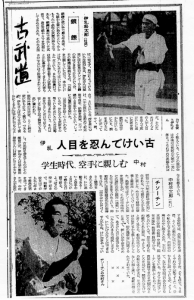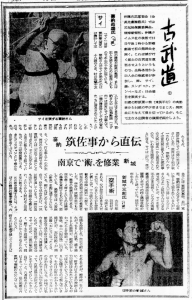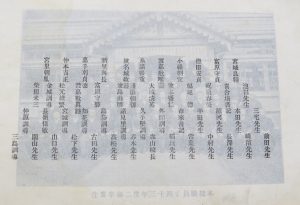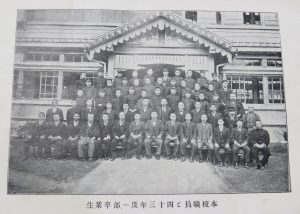Special feature articles
-
2023.09.19
Karate Today - Yoshizato Hiroshi's Birth!
-
2023.08.29
Karate Today - Honolulu Karate Youth Club Found...
-
2023.08.15
Karate Today - Nakandakari’s Birth!
-
2023.08.03
Karate Today - Noma Seiji made his wedding in O...
-
2023.07.18
Karate Today - Yabu Kentsu conducts Karate prom...
-
2023.07.04
Karate Today - First "Karate Club" created for ...
-
2023.06.20
Karate Today - Yoshimura Chogi visited the form...
-
2023.06.06
Karate Today - Karate club at Prefectural First...
-
2023.05.26
Karate Today series will begin
-
2021.12.20
Martial arts demonstration in front of the king...
-
2021.03.08
Folktale: Why tigers can't climb trees
-
2020.12.22
About Rei – Part 2 by Nakamoto Masahiro
-
2020.11.17
Okinawa Karate "WA" Series
-
2020.10.05
About Rei – Part 1: Mabuni Kenei
-
2020.06.19
1969 article on master Yagi and Sūpārinpe
-
2020.05.22
1969 article on master Higa and Passai Dai
-
2020.05.08
1969 article on master Shimabukuro and Ānankū
-
2020.04.20
1969 article on master Kushi and Wankan
-
2020.04.14
1969 article on masters Kaneshima and Nagamine
-
2020.04.09
Article ”Even at 80 years old “Eyaa!” ” (Okinaw...
-
2020.04.09
Article ”Impressed with every move” (Ryūkyū Shi...
-
2019.12.03
Kobudō 9: Nakaima Kenkō and Uchima Anyū
-
2019.11.07
Kobudō 8: Kyan Shinei and Kaneshima Shinei
-
2019.10.29
Kobudō 7: Ishikawa Hōei and Higa Seitoku
-
2019.10.08
Kobudō 6: Nohara Kamaichi and Takara Shigeru
-
2019.09.13
About the estimated new photo of Itosu Ankō
-
2019.09.02
Karate policemen protecting the safety and secu...
-
2019.07.02
Kobudō 5: Soken Hōhan and Shiroma Taisei
-
2019.06.08
Kobudō 4: Kameshima Shinsuke and Chinen Masami
-
2019.06.01
Kobudō 3: Nakamura Shigeru and Higa Yūsuke
-
2019.05.24
Kobudō 2: Irei Matsutarō and Nakamura Heisaburō
-
2019.05.14
Kobudō 1: Kina Shōsei and Shinjō Heisaburō
-
2019.04.08
Questioning the weapons’ hunt
-
2019.01.21
Kyō Ahagon Jikki, the sword and karate
-
2018.05.04
The unveiling of the statue of Uechi Kanbun
-
2017.12.26
Following the steps of Matsumora Kōsaku
-
2017.10.20
Brushwork of late Matsumura Sōkon
-
2017.10.14
Maekawa bō performed at the Shihan Gakkō
-
2017.09.08
The declaration of the "Karate Day"
-
2017.08.15
A district connected to karate, Uebaru
-
2017.07.14
The beauty of Okinawa karate
[ Okinawa Times ] November 16, 1961
Kobudō 2
Training secretly
Irei Matsutarō (82)
Kusarigama
Expert of Kusarigama - sickle and chain weapon, and the eldest senior, he started learning when he was 19 years old, which makes him a man with a martial art experience of more than 60 years. Kusarigama is a martial art that was developed in farm villages where people thought of linking the familiar chain and sickle into a single weapon. Therefore, while there is not one defined kata, many forms can be found depending of the region. Mr. Irei learned Kama-no-te from Asato no Tanmei (1) who lives in Goeku (2). However, his motive was quite simple. He explains that “I was aspiring to become a soldier and I didn’t want to be laugh at when going in Mainland Japan…” Also, at that time in farming villages, people who studied karate and sickle were hated as they were considered as savages and thugs. People kept away from them even to the point that they couldn’t find a spouse. For such reasons, most people were studying martial arts incognito at night, away from people’s attention.
He first started with karate and with his skill leveling-up, he studied many other techniques like Sai, Bō and Kama. At 25 years old, he demonstrated for the first time karate and Kusarigama in a play put on in a village and at 31, he performed a large demonstration together with 12 students.
People are told that “Gei ha mi wo tasuku (3).” Mr. Irei himself says that he was able to overcome many disasters because he studied martial arts. This is not simply a question of defending oneself but also to nurture naturally a spirit that helps one to endure hardships.
Nowadays, the number of experts in Okinawa Kobujutsu and especially sickle is diminishing but he is happily teaching all those who sincerely intend to learn the sickle. During the next coming demonstration, many experts of Okinawa Kobujutsu will gather to demonstrate their secrets and it is the purpose of all to popularize Kobujutsu. On his own, Mr. Irei is teaching Sai, Kama and other skill to his grandchild Tomita Nobuyuki (24).
(1) Tanmei is a word that could be translated into grandpa or old man.
(2) Goeku is located in Okinawa City or Koza.
(3) Learn a trade, for the time will come when you shall need it.
Becoming intimate with karate during student days
Nakamura Heisaburō (68)
Chisōchin
He was born in 1893 in Motobu Town Aza Toguchi. When around 17 years old, he got to know karate and until this day, he has continue training as a spiritual cultivation and as a way of staying in good health. During the demonstration, he will perform Chisōchin (1), a kata he says he was initiated to when he was a student by Bushi Kuniyoshi (2) of Nago Town. During the time of Shihan (3), he received instruction from Yabu Kentsū sensei.
About the merits of karate, he tells with a peaceful tone that “Karate is a good exercise to build a strong body and to temper the mind...” A fervent karate enthusiast, after graduating from the Teachers’ College he spent his life as a school teacher until 1957. In each school he was newly appointed, he instructed karate to students. Especially to upper students, he taught Pin-an and kumite among other things, including karate as a regular item of school’s athletic meets. He retired as principal of Motobu Elementary school in 1957 (4). He is presently the head of the Board of Education of Motobu district.
A man who gives a pleasant impression, with a well-balanced appearance forged through karate, he looks much younger than he is actually. Most likely, he was much appreciated by his students when he was a school teacher. Since it is the first demonstration he is participating in, he went looking for a new karategi and now he devotes himself completely to his morning training. “As I will perform in front of the public, I cannot do anything irresponsible. Although I keep training, I am getting old, and I am worried if I can perform well” he says humbly. Yet he can perform karate very powerfully. As he demonstrates Chisōchin facing the camera, his serious facial expression tells anyone that is still in good health. The sounds of joints and the agile handling of his body are such a contrast with his ordinary quiet face, that it fills the space with a dignified feeling.
Notes:
(1) In Japanese, it is written “Chi” and not “Shi” like for the Gōjū-ryu kata Shisōchin.
(2) Alias for Kuniyoshi Shinkichi (1848-1926). According to the “Okinawa Karate Kobudō Encyclopedia”, he was born in Kumoji Village (present Naha), learned Nahate and was considered the equal to Higashionna Kanryō. When 60 years old, he moved to Nago and taught the kata Nisēshi to Nakamura Shigeru of Okinawa Kenpō.
(3) Referring most likely to Shihan Gakkō, the Teachers’ College that was located where today stands the Okinawa Prefecture University of Arts.
(4) According to Motobu Town Motobu Elementary School records, he was appointed principal of the school in April 1946 (Showa 21) as the 15th principal.
[ Okinawa Times ] November 15, 1961
Kobudō 1
With the support of the Cultural Property Conservation Committee, the Ryūkyū Shimpō and the Okinawa Times Newspapers, the Okinawa Kobudō Kyōkai (President Higa Seitoku) will held its first demonstration on November 26th at 13:00 at Naha Theater. This is organized in order to help the resurrection of native kobudō on the verge to disappear. More than 50 authorities from all regions of the island will participate performing around 60 demonstrations among which Bō, Sai, Kama, Nunchaku, Tinbē, etc… From the venerable 83 years old Nohara Kamaichi (Kochinda Village) to 24 years old young men, all are enthusiastic preparing for this demonstration. At this stage, let’s introduce the major demonstrators.
Direct transmission from the police officer
Kina Shōsei (79)
Sai
In the past, sai was worn by Chikusaji (hori) (1) and was used to protect the king, control the crowd or to arrest criminals. It resembles the Jitte of Mainland Japan.
Mr. Kina started the practice of sai at the age of 18, receiving instruction from the seniors and friends of the village. The birthplace of Mr. Kina, Shimabukuro (Koza City) is extremely famous for sai and it is said that it was popularized among the youth of the village as one kind of self-defense. However, it seems that this was only a self-taught style where people learned from mimicking policemen.
Today, there are many experts of sai in Okinawa but there exists no ryuha (2) and kata are not uniformed. The sai technique that Mr. Kina practices was directly transmitted from an Ufuchiku (official title) policeman who performed his duties at Shuri Castle, thus making it an orthodox school. The major techniques of sai are about “hitting, blocking, thrusting and knocking down”, thus making it a martial art for self-defense. Mr. Kina says that he teaches his students advocating, “Under the sky, one cannot commit bad actions, there is no first attack in sai.” For 32 years, he has worked as a teacher and nowadays lives the rest of his life quietly as a Christian. Among his students are Kyan Shin-ei, Izumikawa Kantoku and Kina Shōshin who are famous as sai experts. Laughing with a big voice Mr. Kina jokes saying, “I am already an 80 years old grandpa” but his handling of the sai is sharp. During the soon coming demonstration at Naha Theater, he intends to show the techniques and higher skills that he has spent a lifetime to learn. He was born in in 1882. (3)
(1) “Chikusaji” refers to police force or policeman. The term “hori” designates a policeman of the time of Edo era.
(2) “Ryuha” means school or style
(3) Kina sensei passed away in 1981.
Return to the top page of the series
**********
Studying “jutsu” in Nanking
Shinjō Heisaburō
(47)
Karate-jutsu (1)
He was born in 1914 in Yomitan Village Aza Uza. His father being fond of karate, he became familiar with karate since his young years. On the suggestion of his father, he crossed over to Nanking China at the age of 17 and learned karate-jutsu at the dojo of Kan Mei sensei (2). Karate is not about Buki (weapon) or Gei (arts). The purpose is to temper the mind (3). Karate-jutsu… Mr. Shinjō explains that the meaning of “Jutsu” is the cultivation of the mind. During the demonstration, he is scheduled to put a wire through his arm (4). Since the wire is like a fine metal chopstick, encouraging himself with a kiai, he will pass the wire through his arm instantly. Not a drop of blood is shed. No pain is felt. It is hard to believe that such a skill is of a human being.
To master such a technique, one needs a considerable amount of spiritual training and Mr. Shinjō devoted six years. Although he has developed a strong body conditioned through karate and a thick wad of muscles, he recalls the pain that comes with conditioning.
After the war, he was evacuated to Mainland Japan (Kagoshima). When his Highness Prince Takamatsu visited Kagoshima, he demonstrated karate-jutsu at a welcoming party. So far he had put 18 times a wire through his arm, but the demonstration he did for the reception in honor of Prince Takamatsu was the one that marked him the most. Seeing the performance, the Prince asked him if it wasn’t painful.
Once the wire go through, it is fine. But the mental concentration until realization is very tiring both nervously and physically. “I am very happy to be able to show my skill in public. According to my capacity of applying technique on this day or not will be a turning point. Even if I am the only one in Okinawa to be able to do this karate-jutsu, the Kobudō Association has recommended me, therefore, I have to do my utmost…” says he enthusiastically grabbing a wire. Currently, he runs a shoe-making store in Nishinjō, Naha City (5).
(1) Shinjō Heisaburō is the uncle of Shinjō Heitarō, who is the master of Matsuda Yoshimasa. The 3 men participated to the demonstration. According to the latter, he performed the kata Chintō while Shinjō Heitarō performed Kusari-gama.
(2) No further information on Kan Mei. The reading of the kanji is not sure as it is most likely a Chinese name. It is not sure if it is Kan-mei or Kan as a family name with Mei/Akira as a given name…
(3) In the text, “Seishin no tanren”, that could be translated as tempering or conditioning of the spirit or mind.
(4) A 3.5 mm diameter wire.
(5) At the entrance of Kuninda, the Kume Village of nowadays’ Naha, was a gate called Kume Ufu-mon (big gate). At the end of Kume Street, north east, used to be Nishinjō-mon (East gate). Today, the police box at the end of the street is still called Nishinjō Kōban.
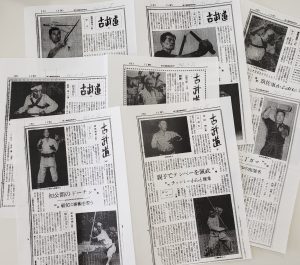
On November 26th, 1961, the Okinawa Kobudō Kyokai (1) held the demonstration called “Dai Ikkai Kobudō Happyōkai” - The 1st Kobudō Demonstration - with the support of the Cultural Property Conservation Committee, the Ryūkyū Shinpō and Okinawa Times newspaper companies. On this occasion, from November 15th to 26th, the Okinawa Times published a series of articles under the title called “Kobudō” introducing 18 martial artists. In the 9 parts of the serial were introduced some famous figures like Kina Shōsei, Nakamura Shigeru, Kaneshima Shinsuke, Chinen Masami, Soken Hōhan, Ishikawa Hōei, Higa Seitoku, Kyan Shin-ei, Kameshima Shin-ei and Nakaima Kenkō among others.
With the permission of the Okinawa Times, we are pleased to introduce the translation of this serial which represents an important piece of legacy for Okinawa karate.
- Okinawa Times - Nov. 9, 1961 “Revival of Kobudō - Kobudō Kyōkai, demonstration on the 26th”
- Okinawa Times - Nov. 15, 1961 Kobudō 1: Kina Shōsei (Sai), Shinjō Heisaburō (Karate-jutsu)
- Okinawa Times - Nov. 16, 1961 Kobudō 2: Irei Matsutarō (Kusarigama), Nakamura Heisaburō (Chisōchin)
- Okinawa Times - Nov. 17, 1961 Kobudō 3: Nakamura Shigeru (Niseshi), Higa Yūsuke (Tinbē)
- Okinawa Times - Nov. 21 1961 Kobudō 4: Kaneshima Shinsuke (Dōchin), Chinen Masami (Sakugawa no kon)
- Okinawa Times - Nov. 22 1961 Kobudō 5: Soken Hōhan (Kusarigama), Shiroma Taisei (Ufutun bō)
- Okinawa Times - Nov. 23 1961 Kobudō 6: Nohara Kamaichi (Shiho kiri), Takara Shigeru (Kiai-justu)
- Okinawa Times - Nov. 24 1961 Kobudō 7: Ishikawa Hōei (Nunchaku), Higa Seitoku (Shōshi no kon)
- Okinawa Times - Nov. 25 1961 Kobudō 8: Kyan Shin-ei (Sai), Kameshima Shin-ei (Naihanchi)
- Okinawa Times - Nov. 26 1961 Kobudō 9: Nakaima Kenkō (Nichō gama), Uchima Anyū (Naihanchi)
- Okinawa Times - Nov. 27 1961 Report on the event
- Ryūkyū Shinpō - Nov. 27 1961 Report on the event
(1) The “Okinawa Kobudō Kyōkai” was founded in 1961. It is not related to the actual Okinawa Prefecture Kobudō Federation. At that time, it was chaired by Higa Seitoku.
(2) Some articles’ translation have already been published on the website of the Okinawa Traditional Karate Liaison Bureau (http://okkb.org/). We are reintroducing these translations with the authorization of the said bureau.
(3) Please note that there may be some errors in the reading of some names. We welcome any suggestions as long as it is provided with corroborative evidence.
On March 7th and 8th, 2019, the Ryūkyū Shinpō Newspaper published a cultural column titled “Easy to understand Okinawan history - Interpreting social changes.” The author is Mr. Kurima Yasuo. Born in 1941 in Naha City, he is an Okinawa historian, agricultural scientist and emeritus professor at Okinawa International University.
In this article, professor Kurima writes about the “Katana-gari” or sword hunt that is said to have occurred at the time of King Shō Shin (1465 - 1527). The event is often mentioned in the history of Okinawa karate. Therefore we take the liberty to reproduce a part of the article in Japanese and present a translation below.
(……)
First of all, let's introduce the most detailed description of official history available in the “Achievements of Shō Shin – ‘Kyūyō’”. The Kyūyō Study Group has read through the ‘Kyūyō’ and compiled 33 points. The fourth point reads as follows. (……)
(4) Swords, bows and arrows were stored to prepare for the defense of our kingdom.
(……)
Next, let's look at the inscription “Momo Urasoe Rankan no Mei”. This asset has not survive history and its author is unknown. Yet, this inscription written in Chinese is mentioned in the "Ryūkyū Kokuhi Bunki". The inscription praises the achievements of King Shō Shin, with 11 items being listed. Some of them are also featured in "Kyūyō". (……)
ⓔ Swords, bows, arrows and similar weapon articles were collected and used exclusively for the defense of the nation.
Were the weapons surrendered?
From ④ and ⓔ, until now, there was an understanding that Shuri Royal Court itself had given up arms, but it was pointed out by many researchers that it was not the case. This is not a royal weapon abandonment, but a statement that the royal court seized weapons in its sole hand. This is fine as an interpretation of the phrase.
Since weapons were collected, some say it was a "sword hunt". If you do not clarify the distinction from the “sword hunt” in Japanese history, it can lead to a misunderstanding. In Japanese history, there was a sword hunt in Toyotomi Hideyoshi's era. However, weapons were not taken away from samurai, but from peasants (farmers) in order to clarify the distinction of social status. In the case of Ryūkyū, it is said that weapons were taken away from "Aji (1)" which are regarded as "Samurai."
So, were weapons really taken away from Aji? Originally, there was no organized armed group in Ryūkyū. While it is undeniable that there must have been some weapons, it is most likely that they were no important items for Aji. From the fact that there was really no weapon stocked, it is hard to believe that the weapons’ recall was written out as an achievement of King Shō Shin. (……)
(1) Local chieftain
Today, March 1st, the Okinawa karate promotion division sponsored “Okinawa Karate Academy” was held within the Okinawa Prefectural Government building. Approximately 30 people from the karate world participated.
The theme of this event, which was the third edition, was the “Re-examination of the Itosu Ankō photo - On the importance of backing up with contemporary historical documents”. Mr. Nakamura Akira, assistant curator at the Okinawa karate promotion division, was in charge of the examination. Today he announced the results of his investigation. Below is a summary of the contents of the announcement. Later on this website, we will introduce a feature article of the presentation.
In 2006, an article titled “Discovery of a photography of a legendary karate master” was published in the Okinawa Times. It was an article reporting the discovery of a photograph of Itosu Ankō (1831-1915), a man who left a huge footprint in Okinawa karate history. Since then, this photograph has been used widely as the photograph of Itosu Ankō. Yet, an examination work has been underway due the recent uncovering of new historical materials.
In the 2006 photograph, Tokuda Antei is present. Mr. Tokuda graduated in 1910 from the Okinawa Prefecture Junior High School (which later became Okinawa Prefectural 1st junior high school). Since the junior high school at that time was a 5 years system, the photo was taken between 1905 and 1910.
Through research and examination of historical documents of this same period, Mr. Nakamura discovered 2 pictures belonging to the Shihan Gakkō (Normal School) magazine “Ryūtan” No. 9. Published in 1911, this document is preserved in the Library of the University of the Ryūkyūs.
Below is one of the two photograhs discovered. It is titled "Our school staff and some graduates of year 43 (1910)". The material to the left is the picture with a tracing paper on which are listed the names of all persons in the photograph. The one to the right is the actual picture. These materials are property of the Library of the University of the Ryūkyūs.
In these photographs, standing to the right end of the second row, the person who was thought to be Itosu Ankō is introduced. However, on the other page's list of names, he is introduced as “Miyake sensei”.
The man believed to be Itosu Ankō until now is actually a Shizoku (descendant of a samurai) from Miyazaki prefecture. Born in 1847, his name is Miyake Sango. He served as a fencing instructor of the Okinawa police while also teaching fencing at the Okinawa Prefecture Normal School and the Okinawa Prefecture Junior High School (later nicknamed Icchū).
Now, looking at the 2006 picture, it is clear that it is not the full version of a group photograph.
The 2006 photo was obtained from the album book of Tokuda Antei by Arasaki Seibin. Mr. Arasaki left a testimony saying “In this group is Ishiji (Itosu) no Tanmē (old man)”. Perhaps Itosu appears in the lost part of the picture…?
Undeniably, the search for solving this mystery will be the source of much passionate debate among karate enthusiasts.
Note: This article is being posted under the supervision of Okinawa karate promotion division.
